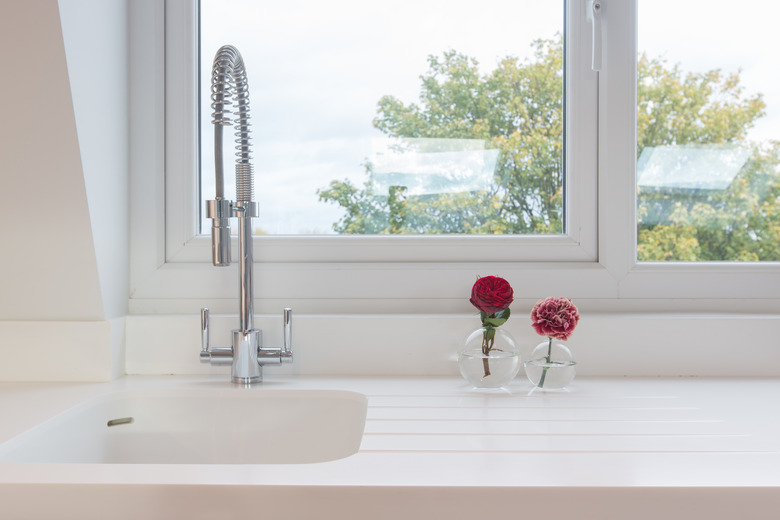Water Flow Vs. Pressure
We may receive a commission on purchases made from links.
When you turn on a faucet and get a trickle of water instead of a steady stream, should you be worried about your water pressure? It isn't an insignificant question because the rate of water flow can be affected by more factors than just the water pressure. The pipes could be constricted, which is common in systems with old galvanized pipes, or the faucet or faucet aerator could just need a good cleaning.
If you really do have low water pressure, you'll notice it in fixtures throughout the house. You might be able to trace the problem back to your pressure regulator, which is usually installed alongside the water meter, or to the pressure pump if you get your water from a well. If you're on a municipal system and one or more neighbors report a similar problem, there could be a disruption in your water supply.
Low flow doesn't necessarily mean low pressure, but low pressure always causes low flow. It's usually fairly easy to tell if your stingy faucet output is due to low flow or low pressure.
Water Pressure vs. Flow Rate
Water Pressure vs. Flow Rate
Water pressure is the force pushing water through your plumbing, and it's usually measured in pounds per square inch (psi). The force could be generated by gravity or by a pressure pump. In a municipal system, the utility company regulates the water pressure entering the house, and the pressure inside can be modified with a pressure regulator, which every home on a municipal system should have.
Water flow is the volume of water that passes a certain point in the pipes in a certain time interval. You seldom need to measure instantaneous flow rate. Instead, it's usually sufficient to measure how much water comes out of a faucet per unit time. The easiest way to measure this is to time how long it takes to fill a bucket of known volume. You can then extrapolate that to get a rate in liters per minute (L/m) or gallons per hour (gph), which are the two most common units.
Check Your Water Pressure
Check Your Water Pressure
The easiest way to tell that you have low water pressure is to note the flow at faucets throughout the house. If a bathroom faucet is trickling, try the shower, and if it also trickles, check faucets in other rooms because there could be a problem with the bathroom plumbing. If all the faucets in the house are experiencing low flow, that's a solid indication of a pressure problem, so the next thing to do is to measure the pressure. You can measure pressure by screwing a pressure gauge onto a faucet with a threaded spout, which you'll find outside or in the laundry room.
After screwing on the gauge and turning off all the other faucets and water-using appliances in the house, open the faucet to which the gauge is attached and note the reading. A reading between 40 and 60 psi is normal if you're on a municipal system, but if you're on a well, the reading could go as low as 30 psi before the pump switches on to pressurize the system. A reading below these numbers indicates low pressure, and just as important, a reading above these numbers indicates high pressure that could cause a leak.
Dealing With Pressure and Flow Problems
Dealing With Pressure and Flow Problems
If your house has a pressure regulator, you can raise or lower the water pressure in the house by turning the adjustment screw on the regulator housing. Turn it clockwise to reduce pressure and counterclockwise to increase it. If you get your water from a well, a number of factors could be responsible for low pressure, including the pressure pump, the pressure tank, or the well itself. If you can't find the cause yourself, your best bet is to call a plumber.
Assuming that water pressure is good, low flow from a single fixture usually means a blockage in that fixture, which you can usually resolve by disassembling the fixture and cleaning it with vinegar. Low flow from more than one fixture indicates a blockage in the plumbing or a valve somewhere that hasn't been fully opened. If you have galvanized pipes and are experiencing low flow, it's probably time to get those pipes replaced because they are corroded and restricting water flow.
